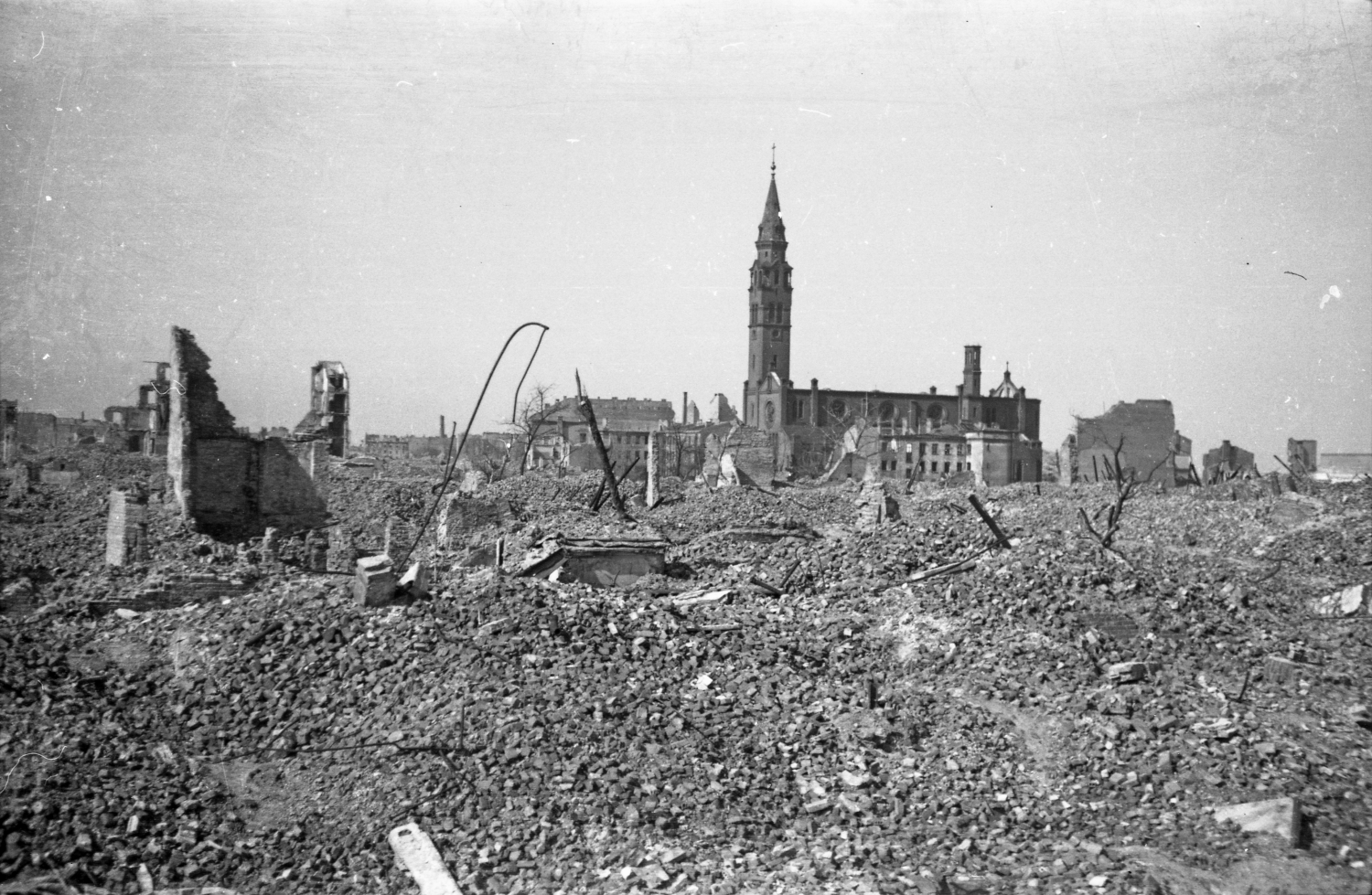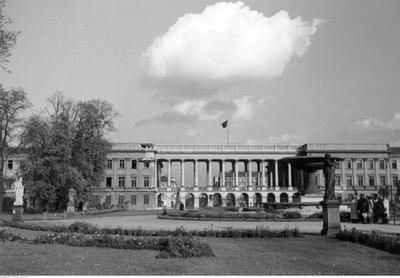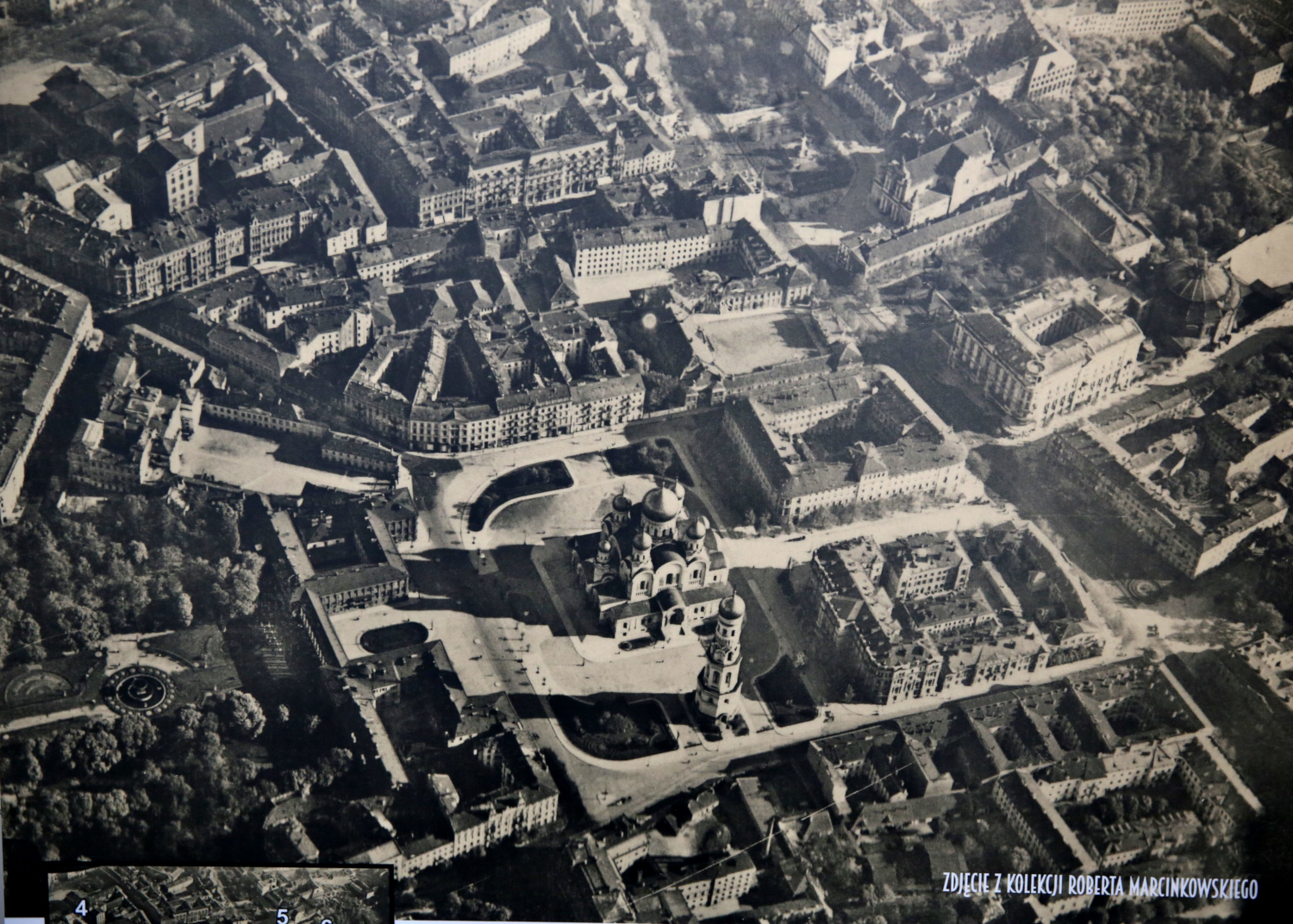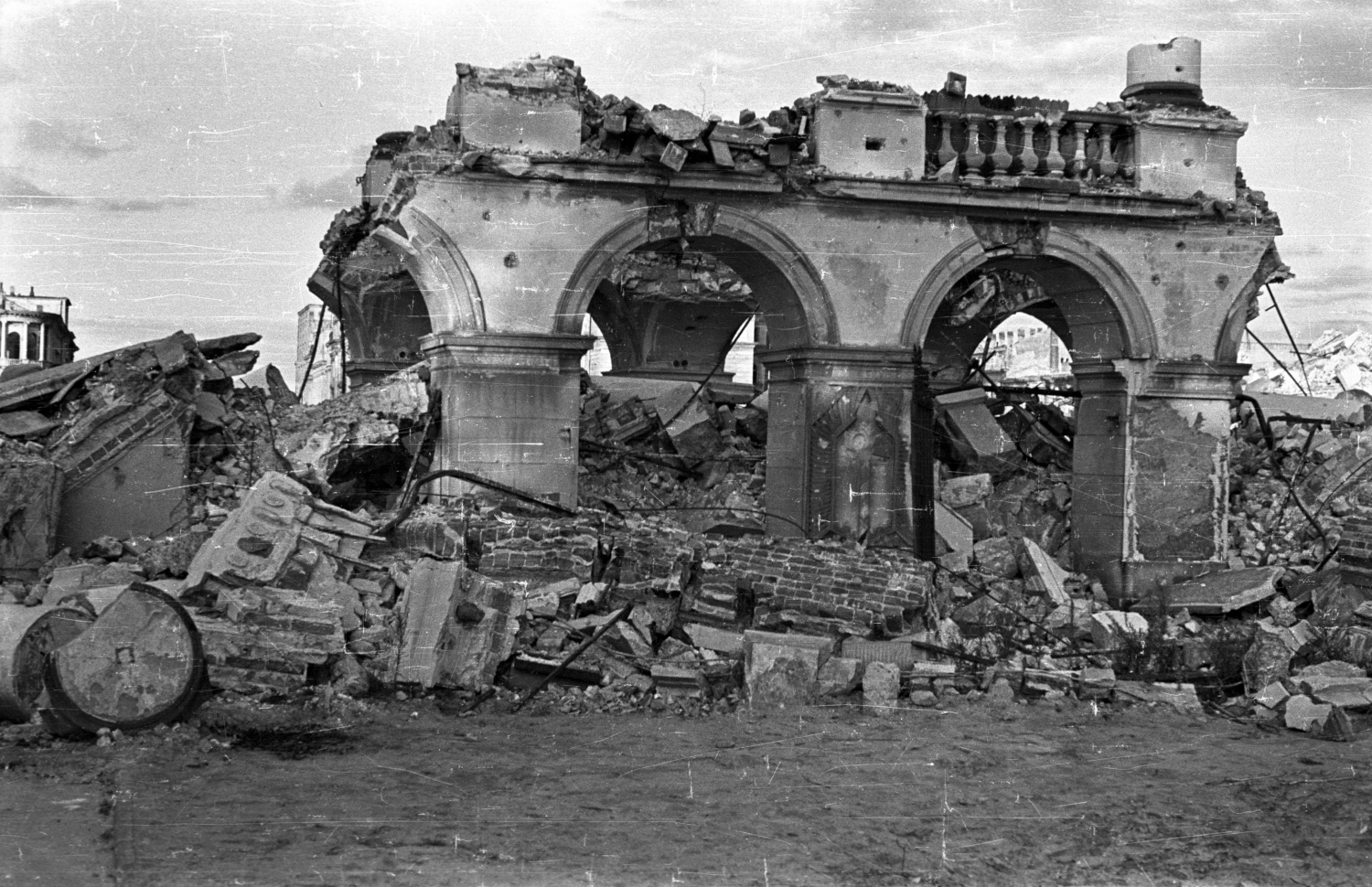THE WARSAW INSTITUTE REVIEW
Date: 2 January 2019 Author: Katarzyna Utracka
Warsaw – the City that is No More
„I wanted a great Warsaw. […] And Warsaw is great indeed”.
(Warsaw, September 23, 1939. Excerpt from the last speech given by the President of Warsaw, Stefan Starzyński)
In 1918, after 123 years under partitions, Poland regained its independence with Warsaw reinstated as its capital, now also home to the highest state institutions. The following two decades saw a dynamic growth of the city with many buildings and public utility premises on the rise.
 Eugeniusz Haneman. Warsaw, Poland, post-war period. Documentation of damages – St. Augustine’s Church at 48/50 Nowolipki Street among the ghetto ruins. © Eugeniusz Haneman (The Warsaw Rising Museum)
Eugeniusz Haneman. Warsaw, Poland, post-war period. Documentation of damages – St. Augustine’s Church at 48/50 Nowolipki Street among the ghetto ruins. © Eugeniusz Haneman (The Warsaw Rising Museum)Undeniably, the city contained many neglected districts, neither beautiful nor big-city like. However, construction of new residential areas surged, and Warsaw boasted some highly modern districts. While the population of Warsaw was just under 800,000 residents in 1918, by 1939 it was already home to almost 1,300,000 people, ranking the seventh biggest city in Europe, ahead of Rome or Madrid. Despite being a very industrialized city, Warsaw was beautiful, diverse and truly European, often referred to as „the Paris of the North”.
Stefan Starzyński, the President of Warsaw, had many ideas regarding the future development of the city. Those ideas included construction of a subway system, bus and train stations, an airport, and even holding a world’s fair. These amazing projects were abandoned, though, after WWII began; The war that would soon totally annihilate the city. Much of the remnants that survived the war were later demolished but Warsaw is a city of an untamed spirit. Like a phoenix, it has risen from the ashes.
Commonplace terror
Warsaw was the first capital to resist the brutal totalitarian regime. After four weeks of heroic defense, the capital of Poland capitulated on September 28, 1939. A few days later, a victory parade was organized, with triumphing troops welcomed by Hitler himself. This began the occupation period that was to last for five deadly years.
From the early days of the occupation, the Nazis imposed ruthless terror aimed at the annihilation of the Polish population. Warsaw, as not only the biggest but also the most vital Polish city, with vibrant social, political and cultural scenes, was particularly targeted.
The hostile approach of the oppressor towards Warsaw and its inhabitants is perhaps best exemplified by Hans Frank’s own words. The governor of German-occupied Poland once said: „There is one place in this country which is [the] source of all calamity. It is Warsaw. If the General Government did not include Warsaw, we would be facing 80% less of adversity right now. It is home to all disorder, which later spreads all over the country”[1].
The occupying forces immediately proceeded with establishing of administration and police structures. The brutal tactics employed by the latter were meant to deter any resistance or cultural and economic activity. Frequent document controls, revisions, arrests and executions quickly became commonplace in the streets of Warsaw. Even the president of Warsaw, aforementioned Stefan Starzyński, was among those arrested. Having been -the co-organizer of the defense of Warsaw under the siege in September 1939, he was murdered by the Gestapo in December 1939. The exact location of his execution remains unknown to this day. Day to day, passers-by were massively arrested in street round-ups. As a result, most of them were sent off to do forced labor in the Third Reich or were transported to concentration camps. Advertising pillars were plastered with subsequent execution announcements. German terror did not discriminate against anyone: everyone could become a victim.
Warsaw’s future under the Third Reich
According to the Nazi plan, the city was gradually stripped of its metropolitan attributes as its status lowered to that of a provincial town. The occupying forces made terrifying plans regarding Warsaw’s future. At the outset, they issued a regulation preventing the removal or repair of the ruins so that the residents would be constantly reminded of Poland’s defeat in 1939. Then Warsaw was to be reconstructed and germanized.
Hubert Gross and Otto Nurnberger, two German architects, arrived in Warsaw as early as December 1939. They were previously responsible for reconstructing Würzburg so that it would suit the needs of the NSDAP. In Warsaw, their tasks included preparing demolition plans as well as devising „Die Neue Deutsche Stadt Warschau” or the new German city. According to this deranged plan, the population of Warsaw was to be reduced to mere 130.000, concentrated within an area 10 times smaller than before. The area east of the river was to incorporate a camp for around 30.000 Poles. According to subsequent projects, after the city center was razed to the ground, it was to be replaced by monumental Nazi architecture. As a result, the Royal Castle, a symbol of Polish rule and the official seat of the president, would be replaced by a NSDAP Congress Hall. The Sigismund’s Column would be turned into a giant statue of the Germanic goddess of victory. At the same time, due to growing war costs, the city was turned into a manufacturing center, producing equipment for the German army.
 Warsaw, Poland, 1939 – 1944, Saski Palace – general view, before the war. © The National Digital Archives
Warsaw, Poland, 1939 – 1944, Saski Palace – general view, before the war. © The National Digital ArchivesThe Nazis put their villainous plans into action during the Warsaw Uprising as well as immediately after its collapse. The speech of Reichsführer SS Heinrich Himmler is particularly telling. He gave it before the German commanders of military districts and headmasters of military academies on September 21, 1944 while the Uprising was still ongoing: „Historically speaking, it is a blessing that Poles went for it. We will have dealt with it within five to six weeks and then Warsaw, the capital, the head, the brain of this 16 or 17–million nation will be destroyed. That nation stood in the way of our quest for the East for 700 years, ever since the first battle of Tannenberg. But then, historically, the Polish issue will no longer be big for our children or those who come after us, nay, it will not even be big for us”[2].
Annihilation of the city and its inhabitants
The annihilation of Warsaw was carefully planned and done in stages. The nearly one-month-long siege of Warsaw in September 1939 was its first instalment. Over 10% of the city structures were destroyed, leaving 6,000 soldiers and 10,000 civilians dead. Śródmieście, or Warsaw’s city center, suffered the most, especially under the bombings. Heavy damage was sustained in the suburban areas of the city, where fierce battles were fought. Warsaw’s prestigious buildings were damaged by bombs as well. This included the Royal Castle, numerous palaces, the National Theater, Warsaw philharmonics and the stock exchange.
Having seized the city, the Nazis immediately began looting valuable artwork, industrial machinery, luxury flats and estates of civilians considered to be of Jewish origin.
Following the German attack on the Soviet Union in June 1941, Nazi-occupied Warsaw was targeted by Soviet bombings. While the Soviets wanted to destroy strategic infrastructure, their bombs often landed on residential areas, damaging numerous tenement houses.
In 1939, Warsaw was home to the second largest Jewish population in the world, just behind New York. In autumn of 1940, the German authorities established an all-Jewish district, isolated from the city, thus creating the largest ghetto in occupied Europe. Approximately 400,000 people were concentrated within an area of less than 1 square mile. In 1941, the population rose to an unprecedented 460.000 people. The Jews, consigned to extermination, were used as cheap labor. Within a year and a half of ghetto’s existence, over 100,000 people died of hunger or emaciation. In 1942, as part of a major liquidation operation, the Nazis sent over 300.000 Jews to the extermination camp in Treblinka. The following deportation attempts were met with resistance. In April 1943, the Jewish uprising in the ghetto began. As a result, 60.000 Jews were either killed or sent to camps. After the Uprising failed, the Nazis methodically razed the ghetto down to the ground. This meant that another 15% of Warsaw’s architecture was destroyed and a substantial chunk of Warsaw’s city center was turned into a wasteland.
August 1, 1944 saw the beginning of another uprising in Warsaw. This time, the soldiers of the Polish Underground State rose up against Nazi rule. Despite being largely outnumbered by the Germans, the Poles fiercely resisted the occupying forces for 63 days. It was one of the most brutal urban battles to date. Upon learning about the revolt in Warsaw, Hitler and Himmler issued the flagitious order to kill all the inhabitants and have the city totally flattened. This total eradication of the city was supposed to deter other nations of occupied Europe from resistance. The order was executed accordingly and started in the early days of the uprising. Captured insurgents and civilians were executed throughout the city. Each district regained by the Nazis was pacified which meant that murders, rapes, and arsons were widespread. The most appalling crimes were committed in the western parts of the city, in the Wola and Ochota districts, where approximately 50,000 men, women and children were murdered within a few days. Overall, it is estimated that 130.000–150.000 civilians were killed in Warsaw. The losses sustained by the insurgents were considerably smaller, with estimated 18.000 deaths. As a result of the heavy bombings and artillery shellings, nearly 25% of the city was destroyed.
The process of Warsaw’s complete eradication was completed soon after the uprising failed. According to the cease-fire, the Home Army was to lay down weapons and surrender. The civilians were banned from Warsaw as well. Within the few days following the collapse of the uprising, columns of people marched down the suburban roads, carrying the remainder of their belongings, leaving the annihilated city behind. The city was about to go through one of the most dramatic periods in its history. In total, the Nazis displaced over 500,000 civilians, often confining them to death, hunger and aimless wander. 350.000 Varsovians deemed unfit for work were displaced within occupied Poland, the remaining 150.000 were sent to forced labor in the Third Reich and around 60.000 were deported to concentration camps. Warsaw was to be razed down to the ground and become a mere transfer point for Wehrmacht after it was carefully cleared of all material goods.
Following the displacement of Warsaw’s inhabitants, special units looted whatever was left in the city. These tasks were divided between three independent departments: the military, the civil department and the SS joined by police forces. Each specialized in a specific area. The Wehrmacht was responsible for disassembling and taking factory machinery, appliances, commodities, food, textiles, cables, electrical wires, etc. The SS plundered in search of textiles, furs, carpets, money and other valuables. Ludwig Fischer, the governor of the Warsaw district, and Artur Greiser, the governor of Wartheland, were even involved in a dispute over who was entitled to take furniture from Warsaw. One researcher, Marian Chlewski, estimates that during that period alone, the Nazis transported 45.000 train cars of looted goods from Warsaw.
After a given district was carefully searched for any valuable objects, it was taken over by Brandkommando fire-squads. Sticking to the plan, they set fire to every house, one after another, district by district. In addition to monuments and residential areas, the Brandkommando destroyed industrial plants, city amenities, tramlines, electrical grid and telephones lines. The fire-squads were backed by Technische Nothilfe special units, that is, sapper police forces. Their joint mission was completed on January 16, 1945. As a direct result of these operations, 30% of the city was annihilated – more than the damage incurred during the two-month long uprising. During this time, some of the most important monuments and buildings of vital importance to the Polish state were destroyed. It should be underscored, though, that the Royal Castle, among other objects, was already blown up during the Warsaw Uprising after it was bombed initially in 1939.
In October 1944, the Nazis burnt down the Krasiński Library, located at Okólnik Street, which was until then used as a storage space for manuscripts and old prints belonging to nearly all Warsaw’s libraries. In late October and early November 1944, the Municipal Archives and the New Records Archives were burnt down as well. In December, the Saxon Palace was blown up, thus demolishing the pre-war seat of the General Staff of the Polish Armed, leaving only the Tomb of the Unknown Soldier untouched. In January 1945, the occupying forces managed to burn down the Public Library of the Capital City of Warsaw while numerous religious establishments were demolished, including the St. John’s Archcathedral, located in the Old Town.
Only the buildings used by the Germans as storage or quarters survived. Some were left out, because the Nazis simply ran out of time. This was the case with many public utility buildings like the Copper-Roof Palace, the National Museum or the Belweder Palace. All of them survived even though they had already been prepared to be blown up. Similarly, the magnificent Palace on the Isle in the Łazienki Royal Park was set on fire with holes later drilled in it in preparation for detonation, which never materialized.
However, Warsaw’s Old Town and the ghetto sustained the most damage. The Old Town was nearly wiped off the face of the Earth. In 1945, there was only one building fit for residential purposes. Looking towards the ghetto provided an equally grim experience as debris stretched beyond the horizon. A famous picture depicting the St. Augustine church standing alone among a sea of ruins at Nowolipki Street depicts an overwhelming eeriness. Under the occupation, the church was incorporated into the ghetto. The Germans used it as a storage space for furniture looted from Jewish flats. Afterwards, it was turned into a stable. It is one of the very few buildings located within the ghetto that survived the war. During the Warsaw Uprising, the church tower was used as a Nazi viewpoint and as a machine-gun nest. After the uprising came to an end, the Germans ignited only the church roof.
 Warsaw, Poland. Photo of Saski Square with St. Alexander Nevsky Cathedral from before November 1917. Photos from the exhibition of the oldest aerial photographs of Warsaw taken by German aviators in the years 1915–1918.
Warsaw, Poland. Photo of Saski Square with St. Alexander Nevsky Cathedral from before November 1917. Photos from the exhibition of the oldest aerial photographs of Warsaw taken by German aviators in the years 1915–1918.Warsaw sustained unimaginable damage. No other European city suffered as much. Around 80% of its buildings laid in ruins. The Germans destroyed every bridge and station in the city. 90% of monuments, 80% of hospitals, 75% of schools and industrial plants were non-existent. City of Ruins, a short film commissioned by the Warsaw Rising Museum and based on archival footage, can yield some understanding of the heinous crimes committed against Warsaw. The bird’s eye view of the city as of spring 1945 reveals the unimaginable extent of the damage sustained.
In 2004, Lech Kaczyński, then the president of Warsaw, commissioned a report on war damage. It estimated that material losses sustained by the city itself as well as by its inhabitants amounted to 54 billion dollars. Figures, however, cannot account for the unquantifiable damages resulting from this period. How can we make a valuation of losses in archival and museum collections? What about privately-owned collections with objects passed down from generations? As a result of the war, Poles irretrievably lost countless objects that were crucial to their national identity. It is by nature, unquantifiable in dollar amounts.
A city does not exist without its people who contribute to it and shape it. Warsaw lost 700,000 of its inhabitants. It is an unimaginable and nearly uncountable number. It was not until 1956 that Warsaw regained its lost population.
From the ashes
For a few months following the collapse of the Uprising Warsaw, this once big city, a state capital, basically laid waste. The Soviets started their offensive as late as January 12, 1945. A few days later, troops from the Polish First Army marched into the eradicated and deserted city, and more specifically onto its westside riverbank. The army took control of it in just a few hours due to the Nazis pulling out a majority of the troops in the city out of fear of being surrounded by Polish troops. Two days later, the Polish First Army ceremoniously paraded on Jerozolimskie Avenues, Warsaw’s main artery, which had been cleaned of debris for the occasion. The troops saw no cheering crowds though as Warsaw was then inhabited by only 22,000 residents, who settled mostly in remote parts of its western side of the river. Warsaw’s central area was still deserted, with only several hundred ‘Warsaw Robinsons’, who chose to remain in hiding. The eastern side of the river looked more lively. It had been coming back to life for several months after the Red Army seized control over it in mid-September 1944 (it then halted its offensive waiting for the uprising to fall). In January 1945, it had nearly 140,000 inhabitants.
The returning inhabitants tried to build their lives anew amid omnipresent rubble. In March 1945, Warsaw was already home to 310,000 residents. Two months later the number soared to 377,000. Not everyone came back, though. Some of those who endured the war chose to disperse around Poland and throughout the world.
The decision on the capital’s reconstruction was made on the January 12, 1945, even before the Polish First Army advanced into the eastern side of the capital. Some three weeks later, the Office for the Reconstruction of the Capital was convened but the main task was still to clear the city of mines and other explosives. Simultaneously, rubble was being removed from the streets, destroyed objects registered and bodies exhumed. Recreating the city’s lost architecture quickly became a priority. Already in January 1945, the army built the first makeshift bridge. Soon several more were added.
Some among the employees of the office dreamed of creating a brand-new Warsaw through embracing social realism. In order to do so, they destroyed the remnants of the old and traditional 19th–century architecture thereby beginning the demolition of tenement houses which were actually suitable for reconstruction. It was an operation done on a massive scale. Within a few months a dozen streets were stripped of housing structures; but it did not end there. Monuments, also suitable for reconstruction, were readily torn down if they stood in the way of new communication routes. Erected in 1955 as ‘a gift from the Soviet Union to the people of Poland,’ the Palace of Culture and Science became the new symbol of Warsaw. Named after Stalin, the monumental structure was built at a breakneck pace with its construction completed within three years. In order for it to stand at the very heart of the city, a decision was made to destroy approximately 180 tenement houses, which could have otherwise been rebuilt.
 Warsaw, Poland, photograph taken after the war. Tomb of the Unknown Soldier and the ruins of the Saxon Palace. © Józef Jerzy Karpiński „Jerzy” (The Warsaw Rising Museum)
Warsaw, Poland, photograph taken after the war. Tomb of the Unknown Soldier and the ruins of the Saxon Palace. © Józef Jerzy Karpiński „Jerzy” (The Warsaw Rising Museum)For a long time, it was not clear what to do about Warsaw’s historic center. Meanwhile, piles of debris often reached up to the second-floor level. Eventually, it was decided that the Old Town and the New Town (both being Warsaw’s historic center) were to be rebuilt. The work was completed in the mid-1950s with historic tenement houses regaining their 18th-century appearance. It took much longer to decide on the fate of the Royal Castle. The debate around it had a clear political subtext. Eventually, the Castle was rebuilt between 1971–1984. The works were financed by social contributions. In 1980, both the reconstructed Royal Castle and Warsaw’s historic center were listed as a UNESCO World Heritage Site.
But Warsaw’s cityscape had lost many buildings of importance for Polish culture and statehood. One of the greatest losses was undoubtedly the Saxon Palace, located at one of the most important plazas in Warsaw. Its history spanned four centuries. It changed its owners, its status and functions and before the war, it was home to the General Staff of the Polish Army. After the collapse of the Warsaw Uprising, it was blown up by German troops. Solely pieces of the central arcade survived the explosion, which continues to house the Tomb of the Unknown Soldier today. On the November 11, 2018, as Poles were celebrating the centenary of Poland regaining independence, the president of Poland, Andrzej Duda, announced plans to reconstruct the palace. The reconstruction of Warsaw, therefore, continues to this day.
Modern Warsaw
In 1989, the political breakthrough brought a new era in Warsaw’s history. The city gradually built its position as an important financial center, luring both national and foreign investors. Today’s Warsaw has a population of 1.7 million people and this dynamic growth is expected to continue. The city does not cease to renew itself, becoming ever more beautiful, modern and functional. Warsaw is also home to an ever-growing labor market with a growing number of foreign investors settling here. New luxurious housing and office complexes designed by foreign architects are added to the landscape on a frequent basis.
In order to be able to understand modern Warsaw, one must first know its history. Its painful, yet glorious experiences make it a truly special place. Countless memorials and monuments scattered around the city are a constant reminder of its difficult and tumultuous past. A few buildings still carry shelling marks but gradually disappear from the cityscape. They evoke the interbellum Warsaw, gone forever, its heroic defenders, and the tragedy of this untamed city.
[1] Okupacja i ruch oporu w Dzienniku Hansa Franka 1939–1945, vol. 2: 1943–1945, edited and compiled under the supervision of S. Płoski: L. Dobroszycki et al., Warsaw 1970, p. 327–328.
[2] Zbrodnie okupanta w czasie Powstania Warszawskiego w 1944 roku (w dokumentach), edited by S. Datner, K. Leszczyński, Warsaw 1969, p. 306.
All texts published by the Warsaw Institute Foundation may be disseminated on the condition that their origin is credited. Images may not be used without permission.














